
During the three hour drive from the concrete and buzz of city life to the romantic farming community of Caledonia, one can’t help but welcome the unexpected change in landscape. You’re no longer surrounded by a flat plains, but rather the rolling hills of bluff country amongst the self-proclaimed “mountains of Minnesota.” It’s easy to understand what drew the French-born Christian Gasset and his wife Liz to this breathtaking pocket of land. The views and ambiance are not unlike where he grew up in France.
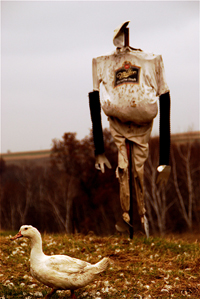
The Gassets are the owners and operators in charge of Au Bon Canard, a Minnesota duck farm supplying locals with breasts, wings, and all other parts duck. Perhaps most notable, however, is their foie gras (pronounced fwah-grah). According to French rural code, foie gras is the liver of duck or goose, fattened by gavage — a force-feeding technique that has been targeted by animal rights activists and defended by Michael Pollan, among others. The mouthwatering delicacy was historically considered an elite treat in France until its popularity and demand migrated across the Atlantic, where it’s now a regular item on American menus. Some examples of its presence in local restaurants are the Foie Gras Meatballs at 112 Eatery and seasonal dishes at La Belle Vie and Heartland. (La Belle Vie is currently offering a Seared Foie Gras with Buttercup Squash and Pistachio, while foie gras appeared on Heartland’s daily-changing menu last week.)
Au Bon Canard is one of three foie gras producers in the country. Compared to the competition, they operate on a highly artisanal scale, delivering roughly 2,000 ducks per year – Sonoma Foie Gras in California and Hudson Valley Foie Gras in New York produce around 10,000 per week. Also unlike larger producers, Christian and Liz operate as a two-person team, only bringing in outside assistance during the slaughter. An additional bonus for Minnesota residents – sales are limited to Minnesotan restaurants and distributors. Around 90 to 95 percent of their product stays in state and they utilize a local distributor, Great Ciao, based in Minneapolis.
As of late, it seems we’ve all jumped on the “Where does my food come from?” bandwagon. This consumer curiosity is a comfortable match with the absolute open-door policy shared by the Gassets. During a recent tour of the farm, Christian walked through every step of a duck’s life at Au Bon Canard, from their initial arrival to the packaging room.
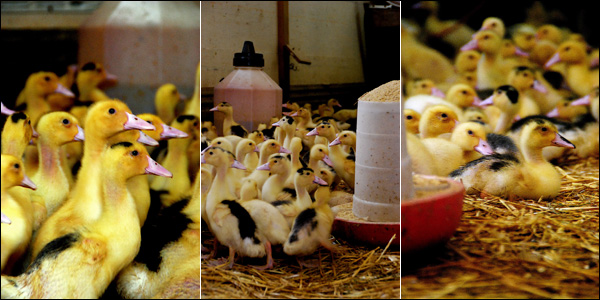
“Hey guys,” he gently murmurs, knocking on the door of the first stop on the tour, the small barn that is the duckling home. Ducks arrive to the farm as one-day-olds and are quickly shuttled in here. The breed, Moulard, is a cross between Muscovy and Peking. (The eggs come from France, but the ducks are born in California.) Gasset clucks his tongue as he swings the barn door open, careful not to startle them or disturb their emotional state. One of the beliefs behind a quality foie gras product is that the ducks endure the least amount of stress possible. “Stress is the number one factor behind taste,” says Gasset in a thick French accent. “That’s why I like to raise them myself, so they know me. When I do the feeding, they know I’m not going to hurt them.”
The small structure, a galley building about 25 feet in length, is home for their first chapter of life at the farm. The straw-lined room is heated to 90 degrees, as the ducklings have not yet grown their feathers, and need help staying toasty warm. “When I first get them, I only use about one third of the building, so they don’t get confused. Then I expand every week.”
Depending on the weather, after a few weeks the ducklings are allowed to take day trips outside. Feathers grow in when they are three to four weeks old, and they can be outside for longer periods of time. After a few more weeks — once they’ve grown all their feathers — they move outside permanently, where they spend their days waddling around the farm grounds. Gates protect them from potential predators, like coyotes. More than one gated pasture exists, so that Gasset can rotate the ducks, replacing them with horses and sheep, and help the terrain follow a natural life cycle. “I don’t want to overuse the land.”
The outdoor groups are quite playful, splashing around in mud baths they created by splattering the water from their trough in the dirt around them. The ground is littered with a thin coat of feathers. The ducks are shedding to prepare for the upcoming winter. Nearly every duck is male. They will produce a larger foie than a female. Their diet consists of a mixed feed, designed especially for Au Bon Canard.
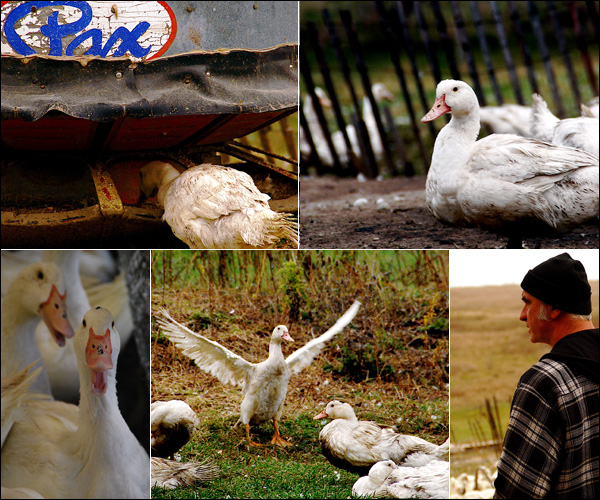
Once they reach 16 to 17 weeks, they are brought into another galley building (often times herded in with help from Fritz, Gasset’s Brittany Spaniel). This building is different than the first. For one, it’s not as warm – temperature remains around 60 degrees. And rather than one long room, it’s filled with several gated open-air cages. The ducks begin their force feeding here. This process, known as “gavage,” is unique to poultry. Normally, one would raise an animal and then simply use it for food, as is. However, foie gras ducks need to have fatty livers and need assistance to eat more than they naturally would. This is where gavaging comes in to play. Typically this is done with the use of a small tube that is placed in the duck’s throat.
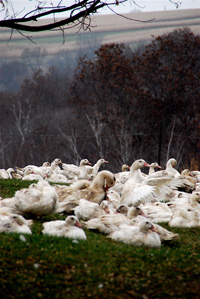
A duck’s digestive system is different from humans in that the food makes a pit stop on the way from the duck’s mouth to its stomach. A small organ, called the “crop,” exists between the esophagus and the stomach and serves as a storage unit for food. If a duck has just eaten, it’s easy to pinpoint the crop as a small bulge at the base of the neck. After they fill up, the food is released from the crop to the stomach as needed. The tube used to gavage reaches just to the crop.
Inside the feeding barn, ducks are put on a strict dietary schedule: Gasset feeds them cooked corn at 6am and 7pm everyday for two weeks. Because corn is more fattening than the mixed feed mixture used outside, he starts them off at a lesser amount. He gradually increases it during the first week. They are fed a pound every day during the second. Maintaining a regular amount is a serious matter. “If they eat 300 grams one day, and 200 grams the next, the foie gras is going to shrink. Then it can turn rubbery.” Gasset tube feeds every duck himself. He sits on a small stool and the duck sits between his legs. The gavage takes about five seconds.
The gavage process differs between every farm. Gasset tries to encourage the duck to force feed themselves at the beginning, so the process is not painful later on. Once the ducks mature, they are put on a new feeding schedule. “We control to amount of corn they are going to eat.” The ducks play outside during the day, sans food. When he opens the feed door at dusk, they swarm to it and eat. “They’re going to eat about a pound of feed in 15 minutes, so they extend the crop themselves.” He saves the force feeding until the latter part of their lives, after they’ve stretched their crop on their own. This method is different from larger operations, where ducks might be force fed from the beginning.
Once the two week indoor feeding period ends, the ducks are prepared for slaughter. A USDA inspector checks them beforehand, verifying that they are alive and well. Then they are brought to the slaughter room (kept insanely immaculate and containing a noticeable odor of cleaning supplies). The ducks are hung upside down and stunned. Then they are slaughtered and bled for several minutes. Gasset doesn’t participate in the slaughter, but he does take charge of removing the feathers. Ducks are dipped in hot water and then go through a de-feathering machine. It’s vital to handle with care: Nobody wants a bruised foie gras.
The ducks are then butchered. Most importantly, the foie gras is carefully removed before everything else. “My wife calls it the jacket,” says Gasset, referring to the breast surrounding the foie. They sell everything from tongues, to beaks, to feet. In total they have sold around 10,000 ducks, and only thrown away two (a noticeably different number than many chicken farms, where 10 to 15 are thrown away every day). Over the years he’s kept a few alive, not because he’s playing favorites, rather thanks to defects like blindness or a deformed beak. He gives them to a teenage neighbor who is interested in farming.
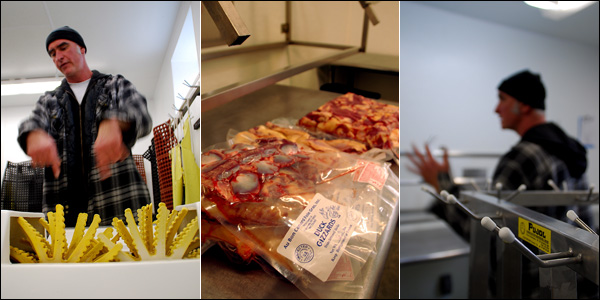
Controversy surrounding foie gras has increased in the last few years. Several locales have forbid the food and the production of it, citing inhumane treatment – Chicago banned foie gras in 2006 and eventually repealed the decision in 2008, while California will ban sale and production beginning in 2012. Bans on force feeding have appeared in several European countries, including Germany and Italy. Mark Caro, an entertainment reporter for the Chicago Tribune, paid a visit to Au Bon Canard for his recently released book, The Foie Gras Wars. After the book was released, Gasset was contacted by a handful of activists. “As I told them how we did things, they didn’t want to bother us.” He believes in forming a connection to his ducks and maintaining a process that is humane and as kind as possible. “I think the activists are against the factory farms,” he says.
Gasset’s artisanal methodology has made a product that is well-respected in the culinary industry. His ducks have even elicited national interest from celebrity chef Thomas Keller. At one point, Keller requested 50 pounds per week from Au Bon Canard. Christian turned him down. “I didn’t want to work for one guy.” He likes having direct contact with the chefs he is working with, and he likes keeping the supply local. Au Bon Canard is used regularly at several Twin Cities restaurants: La Belle Vie, Heartland, Restaurant Alma, Grand Cafe, Cafe Maude, and Cafe Lurcat are all customers. Gasset also sells to Clancey’s Meats in Minneapolis and coordinates crop shares via Cooks of Crocus Hill.
Unfortunately, there have been some instances when Gasset found restaurants were using his name and not his product. “I see some confit or breast on the menu, and I know they didn’t get them from me.” They make about 10 to 15 deliveries per week, and Gasset’s wife acts as delivery truck driver, so they are well aware of where the product is going. “When I catch it, sometimes I get a free meal,” he says, smiling. “But it’s not right.”
He’s reached a point where he feels content with the size of the operation. “I don’t want to grow. I want to focus on quality, not quantity. If I grew I’d have to deal with employees and paperwork. I already have to deal with the ducks.” They’ve been raising ducks since 2003, and turned a profit only two years ago. It’s not about the money, though. “I’m never going to be rich. It doesn’t matter. I’m happy with my lifestyle,” he says. Gasset and his wife don’t have any children. “The ducks are my babies.”

I love this guy. And I love his ducks. And I love his foie gras. Thank you for this article and a for featuring a local artisan farmer filled with integrity and commitment to quality. If all of our food was created with as much sensitivity we’d all be a lot happier and healthier. How ironic, that this foie gras farmer is a model of sustainable and sensitive. And such a gift to Minnesota. Great job!
I guess the term local is somewhat relative – those ducks have a lot of frequent flyer miles by the time they hit your plate from France to California to Caledonia.
Wow — exceptional photos.
And then he eats his babies!! What a baller.
Amazing pictures
What a pleasure to read your beautiful article. Your words flow on to the page and allow the reader to be right at the farm with you.
Great piece! I recently enjoyed a grilled duck breast skewer at Moto-i featuring Au Bon Canard duck; it was fantastic.
We have the pleasure of living near Caledonia and have visited the farm with our son and daughter. Great people–this is a great article! Thanks
Nice pix
The folks in Caledonia may be wonderful people in many ways … and I can’t help but wonder how they feel about the majority of ducks being put through the paces for foie gras production throughout the world — the ones that Roger Moore (aka James Bond) speaks of in his video commentary about foie gras production via the link: http://www.goveg.com/feat/foie/
It is quite obvious that this practice as generally carried out, truly remains extremely inhumane — and this is why it has been banned in over a dozen countries throughout the world and has been criticized by religious leaders as well. Again — judge for yourself as you watch the video at: http://www.goveg.com/feat/foie/
What a wonderful article about a fantastic product. Thanks.
For CJ and others interested in the ethical foie debate –
http://www.ted.com/talks/dan_barber_s_surprising_foie_gras_parable.html
Foie Gras is an inhumane practice and I am saddened by how the writer glossed over this detail. Draw attraction to the experience, and you contribute to the partaking in this type of farming.
By eating the food, you condone the treatment. By frequenting establishments that provide this on their menu, you unknowingly endorse.
I cannot say that having a pipe forced down my esophagus would be anything other than terrible…doubtful to be able to do this “gently” as the writer and farmer states. Check the section on “factory farming” foie gras on http://www.humanesociety.org.
Signed- an aware meat eater
This is an awful practice that should be banned in MN. There is absolutely NO humane way to forcefeed anything!!! Most of these ducks can barely walk because of how much larger their liver is. It is a diseased “delicacy”…diseased liver.
And no activists are NOT okay with his methods. LIES,LIES…wake up people! THIS IS WRONG!
This is awful.
I can’t wait to try their Foi..
Loved the article.
If only people cared this much about our children… And future children
bonjour,
liz et Christian sympa le petit article sur votre ferme.